For our tour description, itinerary,
past triplists, dates, fees, and more, please VISIT OUR TOUR PAGE.
See this triplist in printable PDF format with media only on
page 1.
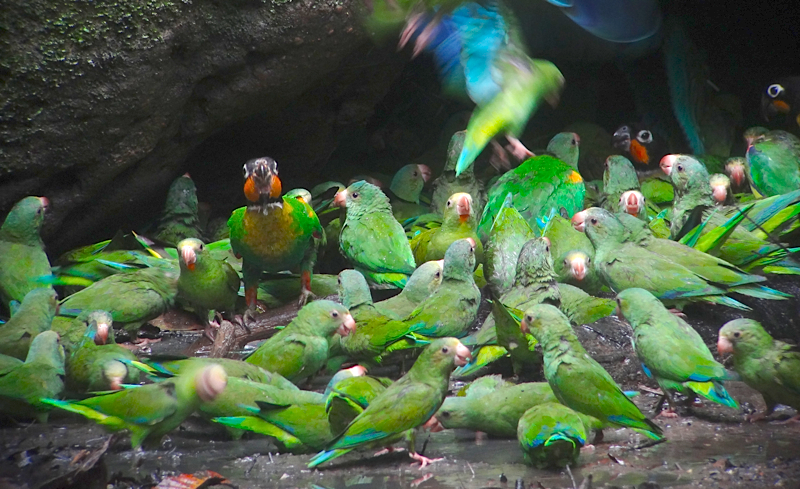
A few gorgeous
Orange-cheeked Parrots peer out from among the cacophonous
crowds of Cobalt-winged Parakeets at the Anangu clay lick.
(Photo by guide Dan Lane)
Well, long story short: we now know why the rainforest is
called a rainforest. Yep, there was a fair amount of rain! But
it wasn't so great a deterrent. We still managed to get out,
see some impressive things, and enjoy the wonders of the
Amazon! Even canoeing in the rain was kind of fun (and did
prove, if nothing else, that we are water-resistant!).
Indeed, the canoe rides we enjoyed on this tour were among
the favorite experiences we had. Others included the visit to
the wooden tower (which is always a pleasure!), and watching
the Mealy, Yellow-crowned, and Blue-headed parrots (and
Dusky-headed Parakeets) push, dangle, and stretch to get to
the best clay at the river-side parrot lick. Several mammals
figured in the list of favorites, including the howler monkeys
draped over limbs as they gave their stomachs time to digest a
hearty meal of leaves, the three-toed sloth who spent the week
in a single Cecropia tree, and the pair of Kinkajous that JN,
the local guides, and I watched staring groggily out of their
roost hole at dusk.
Of course, birds also figured in our adventures, with more
memorable experiences including the awkward Hoatzins at the
edges of the lake, the Scarlet Macaw with its enflamed face
(use more skin cream, dude!), the roosting Great Tinamou over
the boardwalk, the multicolored Paradise Tanager, the still
and unobtrusive Common Potoo on a stick, the large and
ragged-crested Ringed Kingfisher, the electric blue Spangled
Cotinga, and equally colorful Yellow-tufted Woodpeckers that
we enjoyed from the canopy towers. These, and many more, were
among the sights we had while in one of the most diverse sites
in the world‚ with good food, great company, and a fair amount
of fun (and popcorn before dinner!), to boot! I certainly
enjoyed the visit, and hope you all did as well! See you again
out there with binoculars on.
--Dan
KEYS FOR THIS LIST
One of the following keys may be shown in brackets for
individual species as appropriate: * = heard only, I =
introduced, E = endemic, N = nesting, a = austral migrant, b =
boreal migrant
Tinamidae (Tinamous)
GREAT TINAMOU (Tinamus major)
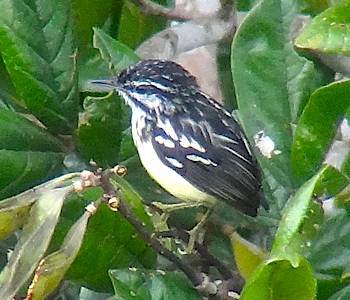
Good thing Sacha
has some wonderful canopy towers; with its preference for
staying high in the canopy of terra firme forest, the
3-inch long Moustached Antwren is not a bird to be looked
for from the ground! (Photo by guide Dan Lane)
CINEREOUS TINAMOU (Crypturellus cinereus) [*]
LITTLE TINAMOU
(Crypturellus soui) [*]
UNDULATED TINAMOU
(Crypturellus undulatus) [*]
VARIEGATED TINAMOU
(Crypturellus variegatus) [*]
Cracidae (Guans, Chachalacas, and
Curassows)
SPECKLED CHACHALACA (Ortalis guttata)
Odontophoridae (New World Quail)
MARBLED WOOD-QUAIL (Odontophorus gujanensis) [*]
Ardeidae (Herons, Egrets, and Bitterns)
ZIGZAG HERON (Zebrilus undulatus)
RUFESCENT
TIGER-HERON (Tigrisoma
lineatum)
COCOI HERON
(Ardea cocoi)
GREAT EGRET
(Ardea alba)
SNOWY EGRET
(Egretta thula)
CATTLE EGRET
(Bubulcus ibis)
STRIATED HERON
(Butorides striata)
CAPPED HERON
(Pilherodius pileatus)
BLACK-CROWNED
NIGHT-HERON (Nycticorax
nycticorax)
BOAT-BILLED HERON
(Cochlearius cochlearius)
Cathartidae (New World Vultures)
BLACK VULTURE (Coragyps atratus)
GREATER
YELLOW-HEADED VULTURE (Cathartes
melambrotus)
KING VULTURE
(Sarcoramphus papa)
Pandionidae (Osprey)
OSPREY (Pandion
haliaetus) [b]
Accipitridae (Hawks, Eagles, and Kites)
GRAY-HEADED KITE (Leptodon cayanensis)
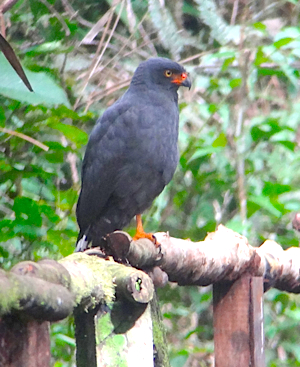
A handsome
Slate-colored Hawk hunts for unwary tourists along the
main boardwalk between the river and the lodge. (Photo by
guide Dan Lane)
SNAIL KITE (Rostrhamus
sociabilis)
SLENDER-BILLED
KITE (Helicolestes hamatus)
DOUBLE-TOOTHED
KITE (Harpagus bidentatus)
PLUMBEOUS KITE
(Ictinia plumbea)
SLATE-COLORED HAWK
(Leucopternis schistaceus)
ROADSIDE HAWK
(Buteo magnirostris)
BLACK HAWK-EAGLE
(Spizaetus tyrannus) [*]
Falconidae (Falcons and Caracaras)
BLACK CARACARA (Daptrius ater)
YELLOW-HEADED
CARACARA (Milvago chimachima)
LAUGHING FALCON
(Herpetotheres cachinnans)
PEREGRINE FALCON
(Falco peregrinus) [b]
Rallidae (Rails, Gallinules, and Coots)
CHESTNUT-HEADED CRAKE (Anurolimnas castaneiceps)
BLACK-BANDED CRAKE
(Anurolimnas fasciatus)
Psophiidae (Trumpeters)
GRAY-WINGED TRUMPETER (Psophia crepitans) [*]
Charadriidae (Plovers and Lapwings)
PIED LAPWING (Vanellus cayanus)
COLLARED PLOVER
(Charadrius collaris)
Scolopacidae (Sandpipers and Allies)
SPOTTED SANDPIPER (Actitis macularius) [b]
GREATER YELLOWLEGS
(Tringa melanoleuca) [b]
Laridae (Gulls, Terns, and Skimmers)
YELLOW-BILLED TERN (Sternula superciliaris)
LARGE-BILLED TERN
(Phaetusa simplex)
BLACK SKIMMER
(Rynchops niger)
Columbidae (Pigeons and Doves)
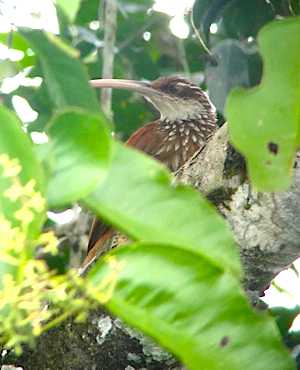
Curious, but
still wary, a Long-billed Woodcreeper peeks out from
amidst thick canopy vegetation, checking out the strange
group of primates in the treetops. (Photo by guide Dan
Lane)
ROCK PIGEON (Columba livia) [I]
PALE-VENTED PIGEON
(Patagioenas cayennensis)
PLUMBEOUS PIGEON
(Patagioenas plumbea)
EARED DOVE
(Zenaida auriculata)
RUDDY GROUND-DOVE
(Columbina talpacoti)
GRAY-FRONTED DOVE
(Leptotila rufaxilla)
RUDDY QUAIL-DOVE
(Geotrygon montana) [*]
Psittacidae (Parrots)
MAROON-TAILED PARAKEET (Pyrrhura melanura)
DUSKY-HEADED
PARAKEET (Aratinga weddellii)
CHESTNUT-FRONTED
MACAW (Ara severus) [*]
SCARLET MACAW
(Ara macao)
BLUE-AND-YELLOW
MACAW (Ara ararauna)
COBALT-WINGED
PARAKEET (Brotogeris
cyanoptera)
SCARLET-SHOULDERED
PARROTLET (Touit huetii)
BLACK-HEADED
PARROT (Pionites
melanocephalus)
ORANGE-CHEEKED
PARROT (Pyrilia barrabandi)
BLUE-HEADED PARROT
(Pionus menstruus)
ORANGE-WINGED
PARROT (Amazona amazonica)
MEALY PARROT
(Amazona farinosa)
YELLOW-CROWNED
PARROT (Amazona ochrocephala)
Opisthocomidae (Hoatzin)
HOATZIN (Opisthocomus
hoazin)
Cuculidae (Cuckoos)
SQUIRREL CUCKOO (Piaya cayana)
GREATER ANI
(Crotophaga major)
SMOOTH-BILLED ANI
(Crotophaga ani)
Strigidae (Owls)
TAWNY-BELLIED SCREECH-OWL (Megascops watsonii)
CRESTED OWL
(Lophostrix cristata)
FERRUGINOUS
PYGMY-OWL (Glaucidium
brasilianum) [*]
Caprimulgidae (Nightjars and Allies)
COMMON PAURAQUE (Nyctidromus albicollis)
LADDER-TAILED
NIGHTJAR (Hydropsalis
climacocerca)
Nyctibiidae (Potoos)
GREAT POTOO (Nyctibius grandis)
COMMON POTOO
(Nyctibius griseus) [N]
Apodidae (Swifts)
WHITE-CHINNED SWIFT (Cypseloides cryptus)
WHITE-COLLARED
SWIFT (Streptoprocne zonaris)
SHORT-TAILED SWIFT
(Chaetura brachyura)
GRAY-RUMPED SWIFT
(Chaetura cinereiventris)
PALE-RUMPED SWIFT
(Chaetura egregia)
LESSER
SWALLOW-TAILED SWIFT (Panyptila
cayennensis)
FORK-TAILED
PALM-SWIFT (Tachornis
squamata)
Trochilidae (Hummingbirds)
WHITE-NECKED JACOBIN (Florisuga mellivora)
RUFOUS-BREASTED
HERMIT (Glaucis hirsutus)
WHITE-BEARDED
HERMIT (Phaethornis hispidus)
STRAIGHT-BILLED
HERMIT (Phaethornis bourcieri)
GREAT-BILLED
HERMIT (Phaethornis malaris)
BLUE-TAILED
EMERALD (Chlorostilbon
mellisugus)
GOLDEN-TAILED
SAPPHIRE (Chrysuronia oenone)
Trogonidae (Trogons)
BLACK-TAILED TROGON (Trogon melanurus) [*]
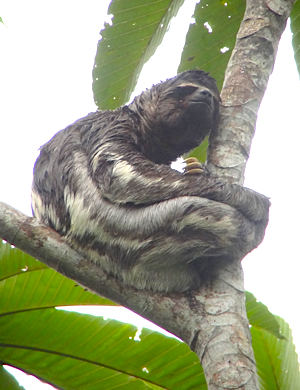
They don't call
them sloths for nothing... this guy spent the entire week
of our stay in a single Cecropia tree! What a life! (Photo
by guide Dan Lane)
GREEN-BACKED TROGON (Trogon viridis)
AMAZONIAN TROGON
(Trogon ramonianus)
COLLARED TROGON
(Trogon collaris)
Momotidae (Motmots)
AMAZONIAN MOTMOT (Momotus momota)
RUFOUS MOTMOT
(Baryphthengus martii) [*]
Alcedinidae (Kingfishers)
RINGED KINGFISHER (Megaceryle torquata)
GREEN-AND-RUFOUS
KINGFISHER (Chloroceryle inda)
Bucconidae (Puffbirds)
WHITE-NECKED PUFFBIRD (Notharchus hyperrhynchus) [*]
WHITE-CHESTED
PUFFBIRD (Malacoptila fusca)
BLACK-FRONTED
NUNBIRD (Monasa nigrifrons)
WHITE-FRONTED
NUNBIRD (Monasa morphoeus)
SWALLOW-WINGED
PUFFBIRD (Chelidoptera
tenebrosa)
Galbulidae (Jacamars)
WHITE-EARED JACAMAR (Galbalcyrhynchus leucotis)
BROWN JACAMAR
(Brachygalba lugubris)
YELLOW-BILLED
JACAMAR (Galbula albirostris)
WHITE-CHINNED
JACAMAR (Galbula tombacea)
PURPLISH JACAMAR
(Galbula chalcothorax)
GREAT JACAMAR
(Jacamerops aureus)
Capitonidae (New World Barbets)
SCARLET-CROWNED BARBET (Capito aurovirens)
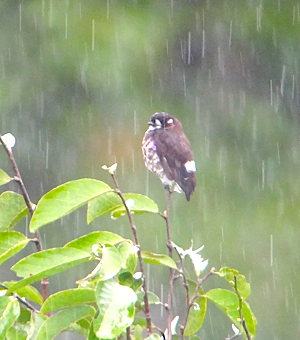
Formerly treated
as a member of the Cotinga family, the tiny White-browed
Purpletuft has recently been placed in the same family as
the tityras and becards. (Photo by guide Dan Lane)
GILDED BARBET (Capito auratus)
Ramphastidae (Toucans)
CHESTNUT-EARED ARACARI (Pteroglossus castanotis)
MANY-BANDED
ARACARI (Pteroglossus
pluricinctus)
IVORY-BILLED
ARACARI (Pteroglossus azara)
GOLDEN-COLLARED
TOUCANET (Selenidera
reinwardtii)
WHITE-THROATED
TOUCAN (Ramphastos tucanus
cuvieri)
CHANNEL-BILLED
TOUCAN (Ramphastos vitellinus
culminatus) [*]
Picidae (Woodpeckers)
YELLOW-TUFTED WOODPECKER (Melanerpes cruentatus)
LITTLE WOODPECKER
(Veniliornis passerinus)
CHESTNUT
WOODPECKER (Celeus elegans)
RED-NECKED
WOODPECKER (Campephilus
rubricollis)
CRIMSON-CRESTED
WOODPECKER (Campephilus
melanoleucos)
Furnariidae (Ovenbirds and Woodcreepers)
TAWNY-THROATED LEAFTOSSER (Sclerurus mexicanus)
SHORT-BILLED
LEAFTOSSER (Sclerurus
rufigularis)
BLACK-TAILED
LEAFTOSSER (Sclerurus
caudacutus)
CHESTNUT-WINGED
HOOKBILL (Ancistrops
strigilatus)
PLAIN XENOPS
(Xenops minutus)
PLAIN-BROWN
WOODCREEPER (Dendrocincla
fuliginosa)
OLIVACEOUS
WOODCREEPER (Sittasomus
griseicapillus)
WEDGE-BILLED
WOODCREEPER (Glyphorynchus
spirurus)
LONG-BILLED
WOODCREEPER (Nasica
longirostris)
AMAZONIAN
BARRED-WOODCREEPER (Dendrocolaptes
certhia) [*]
STRAIGHT-BILLED
WOODCREEPER (Dendroplex picus)
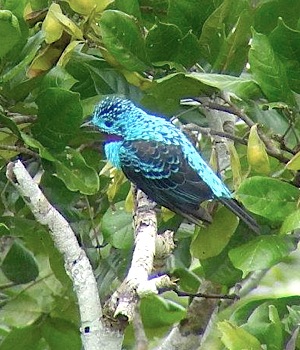
If you like
gaudy, and who doesn't, point-blank views of a male
Spangled Cotinga from the canopy tower are pretty hard to
beat! (Photo by guide Dan Lane)
STRIPED WOODCREEPER (Xiphorhynchus obsoletus)
ELEGANT
WOODCREEPER (Xiphorhynchus
elegans)
BUFF-THROATED
WOODCREEPER (Xiphorhynchus
guttatus)
LINEATED
WOODCREEPER (Lepidocolaptes
albolineatus)
Thamnophilidae (Typical Antbirds)
PLAIN-WINGED ANTSHRIKE (Thamnophilus schistaceus) [*]
MOUSE-COLORED
ANTSHRIKE (Thamnophilus
murinus)
DUSKY-THROATED
ANTSHRIKE (Thamnomanes
ardesiacus)
CINEREOUS
ANTSHRIKE (Thamnomanes
caesius)
BROWN-BACKED
ANTWREN (Epinecrophylla
fjeldsaai)
RUFOUS-TAILED
ANTWREN (Epinecrophylla
erythrura)
PYGMY ANTWREN
(Myrmotherula brachyura)
MOUSTACHED ANTWREN
(SHORT-BILLED) (Myrmotherula
ignota obscura)
PLAIN-THROATED
ANTWREN (Myrmotherula
hauxwelli)
WHITE-FLANKED
ANTWREN (Myrmotherula
axillaris)
GRAY ANTWREN
(Myrmotherula menetriesii)
DUGAND'S ANTWREN
(Herpsilochmus dugandi)
BLACK ANTBIRD
(Cercomacra serva)
BLACK-FACED
ANTBIRD (Myrmoborus
myotherinus)
PERUVIAN
WARBLING-ANTBIRD (Hypocnemis
peruviana)
YELLOW-BROWED
ANTBIRD (Hypocnemis
hypoxantha)
SILVERED ANTBIRD
(Sclateria naevia)
WHITE-SHOULDERED
ANTBIRD (Myrmeciza melanoceps)
PLUMBEOUS ANTBIRD
(Myrmeciza hyperythra)
SOOTY ANTBIRD
(Myrmeciza fortis)
BICOLORED ANTBIRD
(Gymnopithys leucaspis) [*]
LUNULATED ANTBIRD
(Gymnopithys lunulatus) [*]
DOT-BACKED ANTBIRD
(Hylophylax punctulatus)
SCALE-BACKED
ANTBIRD (Willisornis
poecilinotus)
Formicariidae (Antthrushes)
BLACK-FACED ANTTHRUSH (Formicarius analis) [*]
STRIATED ANTTHRUSH
(Chamaeza nobilis)
Grallariidae (Antpittas)
OCHRE-STRIPED ANTPITTA (Grallaria dignissima) [*]
WHITE-LORED
ANTPITTA (Hylopezus
fulviventris) [*]
Conopophagidae (Gnateaters)
CHESTNUT-BELTED GNATEATER (Conopophaga aurita)
Tyrannidae (Tyrant Flycatchers)
YELLOW-CROWNED TYRANNULET (Tyrannulus elatus)
SLENDER-FOOTED
TYRANNULET (Zimmerius
gracilipes)
GOLDEN-FACED
TYRANNULET (Zimmerius
chrysops)
SHORT-TAILED
PYGMY-TYRANT (Myiornis
ecaudatus)
WHITE-EYED
TODY-TYRANT (Hemitriccus
zosterops)
YELLOW-BROWED
TODY-FLYCATCHER (Todirostrum
chrysocrotaphum)
YELLOW-MARGINED
FLYCATCHER (Tolmomyias
assimilis)
YELLOW-BREASTED
FLYCATCHER (Tolmomyias
flaviventris) [*]
EULER'S FLYCATCHER
(Lathrotriccus euleri) [*]
EASTERN WOOD-PEWEE
(Contopus virens) [b]
DRAB WATER TYRANT
(Ochthornis littoralis)
RUFOUS-TAILED
FLATBILL (Ramphotrigon
ruficauda)
CINNAMON ATTILA
(Attila cinnamomeus)
CITRON-BELLIED
ATTILA (Attila citriniventris)
[*]
BRIGHT-RUMPED
ATTILA (Attila spadiceus)
[*]
GRAYISH MOURNER
(Rhytipterna simplex)
DUSKY-CAPPED
FLYCATCHER (Myiarchus
tuberculifer)
SHORT-CRESTED
FLYCATCHER (Myiarchus ferox)
LESSER KISKADEE
(Pitangus lictor)
GREAT KISKADEE
(Pitangus sulphuratus)
BOAT-BILLED
FLYCATCHER (Megarynchus
pitangua)
SOCIAL FLYCATCHER
(Myiozetetes similis)
GRAY-CAPPED
FLYCATCHER (Myiozetetes
granadensis)
DUSKY-CHESTED
FLYCATCHER (Myiozetetes
luteiventris)
SULPHUR-BELLIED
FLYCATCHER (Myiodynastes
luteiventris) [b]
PIRATIC FLYCATCHER
(Legatus leucophaius)
TROPICAL KINGBIRD
(Tyrannus melancholicus)
EASTERN KINGBIRD
(Tyrannus tyrannus) [b]
Cotingidae (Cotingas)
PURPLE-THROATED FRUITCROW (Querula purpurata)
PLUM-THROATED
COTINGA (Cotinga maynana)
SPANGLED COTINGA
(Cotinga cayana)
SCREAMING PIHA
(Lipaugus vociferans)
BARE-NECKED
FRUITCROW (Gymnoderus
foetidus)
Pipridae (Manakins)
DWARF TYRANT-MANAKIN (Tyranneutes stolzmanni) [*]
STRIPED MANAKIN
(WESTERN) (Machaeropterus
regulus striolatus) [*]
BLUE-CROWNED
MANAKIN (Lepidothrix coronata)
BLUE-BACKED
MANAKIN (Chiroxiphia pareola)
[*]
ORANGE-CROWNED
MANAKIN (Heterocercus
aurantiivertex)
WIRE-TAILED
MANAKIN (Pipra filicauda)
GOLDEN-HEADED
MANAKIN (Pipra erythrocephala)
Tityridae (Tityras and Allies)
BLACK-TAILED TITYRA (Tityra cayana)
WHITE-BROWED
PURPLETUFT (Iodopleura
isabellae)
Vireonidae (Vireos)
YELLOW-GREEN VIREO (Vireo flavoviridis) [b]
SLATY-CAPPED
SHRIKE-VIREO (Vireolanius
leucotis) [*]
Corvidae (Crows, Jays, and Magpies)
VIOLACEOUS JAY (Cyanocorax violaceus)
Hirundinidae (Swallows)
WHITE-BANDED SWALLOW (Atticora fasciata)
GRAY-BREASTED
MARTIN (Progne chalybea)
[N]
WHITE-WINGED
SWALLOW (Tachycineta
albiventer)
Troglodytidae (Wrens)
THRUSH-LIKE WREN (Campylorhynchus turdinus) [*]
HOUSE WREN
(Troglodytes aedon)
WHITE-BREASTED
WOOD-WREN (Henicorhina
leucosticta)
Donacobiidae (Donacobius)
BLACK-CAPPED DONACOBIUS (Donacobius atricapilla)
Turdidae (Thrushes and Allies)
HAUXWELL'S THRUSH (Turdus hauxwelli) [*]
LAWRENCE'S THRUSH
(Turdus lawrencii)
BLACK-BILLED
THRUSH (Turdus ignobilis)
GREAT THRUSH
(Turdus fuscater)
WHITE-NECKED
THRUSH (Turdus albicollis)
Parulidae (New World Warblers)
BLACKPOLL WARBLER (Setophaga striata) [b]
Thraupidae (Tanagers and Allies)
MAGPIE TANAGER (Cissopis leverianus)
GRAY-HEADED
TANAGER (Eucometis
penicillata)
FLAME-CRESTED
TANAGER (Tachyphonus
cristatus)
MASKED CRIMSON
TANAGER (Ramphocelus
nigrogularis)
SILVER-BEAKED
TANAGER (Ramphocelus carbo)
BLUE-GRAY TANAGER
(Thraupis episcopus)
PALM TANAGER
(Thraupis palmarum)
PARADISE TANAGER
(Tangara chilensis)
GREEN-AND-GOLD
TANAGER (Tangara schrankii)
MASKED TANAGER
(Tangara nigrocincta)
OPAL-RUMPED
TANAGER (Tangara velia)
OPAL-CROWNED
TANAGER (Tangara callophrys)
YELLOW-BELLIED
DACNIS (Dacnis flaviventer)
BLUE DACNIS
(Dacnis cayana)
GREEN HONEYCREEPER
(Chlorophanes spiza)
PURPLE
HONEYCREEPER (Cyanerpes
caeruleus)
GRAYISH SALTATOR
(Saltator coerulescens)
Emberizidae (Buntings, Sparrows and
Allies)
RED-CAPPED CARDINAL (Paroaria gularis)
Icteridae (Troupials and Allies)
RED-BREASTED BLACKBIRD (Sturnella militaris)
ORIOLE BLACKBIRD
(Gymnomystax mexicanus)
GIANT COWBIRD
(Molothrus oryzivorus)
EPAULET ORIOLE
(MORICHE) (Icterus cayanensis
chrysocephalus)
YELLOW-RUMPED
CACIQUE (Cacicus cela)
[N]
RUSSET-BACKED
OROPENDOLA (Psarocolius
angustifrons)
CRESTED OROPENDOLA
(Psarocolius decumanus)
CASQUED OROPENDOLA
(Clypicterus oseryi) [N]
Fringillidae (Siskins, Crossbills, and
Allies)
THICK-BILLED EUPHONIA (Euphonia laniirostris)
GOLDEN-BELLIED
EUPHONIA (Euphonia
chrysopasta)
ORANGE-BELLIED
EUPHONIA (Euphonia
xanthogaster)
RUFOUS-BELLIED
EUPHONIA (Euphonia
rufiventris)
BLACK-MANTLE
TAMARIN (Saguinus nigricollis)
COMMON SQUIRREL
MONKEY (Saimiri sciureus)
DUSKY TITI MONKEY
(Callicebus moloch) [*]
RED HOWLER MONKEY
(Alouatta seniculus)
WHITE-FRONTED
CAPUCHIN (Cebus albifrons)
BROWN-THROATED
THREE-TOED SLOTH (Bradypus
variegatus)
NORTHERN AMAZON
RED SQUIRREL (Sciurus
igniventris)
BLACK AGOUTI
(Dasyprocta fuliginosa)
KINKAJOU (Potos flavus)
Spectacled (White) Caiman- Caiman crocodilus
River Turtle- Podocnemis sp.
Fer-de-lance- Bothrops atrox
Caiman Lizard- Dracaena guianensis
Guichenot's Dwarf Iguana- Enyaloides laticeps
Totals for the tour: 252 bird taxa and 9 mammal taxa







